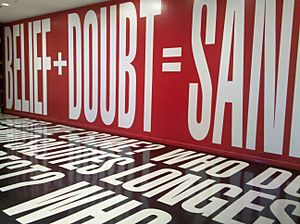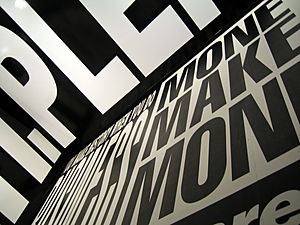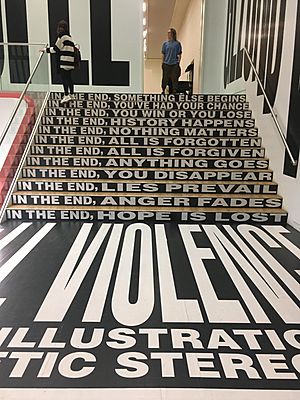Barbara Kruger facts for kids
Quick facts for kids
Barbara Kruger
|
|
|---|---|
| Born | January 26, 1945 Newark, New Jersey, U.S.
|
| Education | |
| Known for | Visual art and graphic design |
| Movement | Feminism, Pictures Generation |
| Awards | Leone D'Oro Venice Biennale Goslarer Kaiserring |
Barbara Kruger (born January 26, 1945) is an American artist known for her unique visual art. She creates powerful pieces by combining black-and-white photographs with bold text. Her art often uses phrases like "you," "your," and "I" to make people think about power, who we are, and how we buy things. Barbara Kruger uses many different art forms, including photography, sculpture, graphic design, and video.
She lives and works in New York and Los Angeles. She is also a respected professor at the UCLA School of the Arts and Architecture. In 2021, Time magazine named her one of the 100 Most Influential People.
Contents
Early Life and Artistic Beginnings
Barbara Kruger grew up in a working-class family in Newark, New Jersey. Her father worked for an oil company, and her mother was a legal secretary.
After high school, she attended Syracuse University for a year. She then studied at the Parsons School of Design in New York. For about ten years, Kruger worked in graphic design for magazines. She also edited pictures and designed book covers. In the late 1960s, she became interested in poetry and started writing her own.
Kruger's early artworks, from 1969, were large wall hangings. These pieces used materials like yarn, beads, and feathers. They showed a new way for women artists to use traditional crafts. Some of her early works were even shown in the 1973 Whitney Biennial art show. However, Kruger felt her art was becoming less meaningful. In 1976, she took a break and moved to California. There, she found new inspiration from writers like Walter Benjamin. She returned to art in 1977, focusing on photographs of buildings and publishing an art book.
When she started her art career, Kruger felt that New York art galleries were not very welcoming to independent women artists. But groups like the Public Art Fund supported her work. In the early 1980s, she began creating the collage style she is famous for today.
Exploring Art and Ideas
Barbara Kruger is often grouped with other feminist artists like Jenny Holzer and Cindy Sherman. Like them, she uses methods from mass communication and advertising. She explores ideas about gender and identity in her art. Kruger is also considered part of the Pictures Generation, a group of artists who used images from popular culture.
How Kruger Combines Images and Words
Much of Kruger's art combines found photographs with short, strong text. This style is known as word art. She develops her ideas on a computer, then prints them, often in very large sizes like billboards. Her famous slogans include "I shop therefore I am" and "Your body is a battleground." These phrases appear in her signature white letters on a red background. Her work often deals with important topics like feminism, consumerism, and personal freedom. She often takes images from magazines and adds her bold text to give them a new meaning.
Kruger has said that she uses "pictures and words because they have the ability to determine who we are." She often takes existing images and changes them. She explains that pictures and words can become "rallying points" for ideas, whether true or false.
For example, in 1989, she created a poster for the Women's March on Washington. It showed a woman's face with the words "Your body is a battleground." A year later, she used this slogan on a billboard.
Kruger's early works were made before digital art was common. She would paste up images and text, showing her experience as a magazine designer. These small works were then enlarged. From 1978 to 1979, she created "Picture/Readings," which were simple photos of houses with panels of words. She also designed covers for magazines like Ms. and Newsweek. Her famous font style, Futura Bold, was likely inspired by 1960s advertising.
In 1990, Kruger planned a mural in Little Tokyo, Los Angeles. It was to feature the Pledge of Allegiance with challenging questions. After community discussions, she changed the mural to just include questions like "Who is bought and sold?" and "Who laughs last?" These questions were painted in the colors of the American flag.
In 1995, she helped design large sculptural letters that spelled Picture This for an outdoor theater in North Carolina. For the Parrish Art Museum in 1998, she put the words "You belong here" on the building's facade. In 2005, at the Venice Biennale, she covered an entire building with words like "money" and "power" in English and Italian. In 2012, her huge installation Belief+Doubt covered 6,700 square feet at the Hirshhorn Museum and Sculpture Garden.
In 2022, Kruger created new artworks about women's rights. She spoke about how important it is for people to have control over their own bodies.
Art in Public Spaces
Barbara Kruger's art has appeared in many public places. In 1994, her work L'empathie peut changer le monde (Empathy can change the world) was put on a train station platform in France. In 1997, she had city buses covered with quotes from famous people. To promote her first big art show in Los Angeles, she created billboards and posters in both English and Spanish. She also covered a bus with phrases like "Don't be a jerk" to promote art education. In 2017, her art was featured on 50,000 special edition MetroCards in New York City.
Art and Fashion
In 1984, Kruger designed a T-shirt with a woman's face and the words "I can't look at you ... and breathe at the same time." She worked with fashion designer Willi Smith on this project. In 2017, Kruger teamed up with the clothing brand Volcom for an art festival. She opened a pop-up shop selling T-shirts, hats, and skateboards with her designs.
Permanent Artworks
Between 1998 and 2008, Kruger created permanent art installations for several universities and museums, including the Fisher College of Business and the LACMA. From 2008 to 2011, the Moderna Museet in Stockholm showed a special work she made for their entrance. In 2012, her permanent installation Belief+Doubt was installed at the Hirshhorn Museum and Sculpture Garden in Washington, D.C. In 2024, she was chosen to create art for the new Terminal 6 at John F. Kennedy International Airport, which is expected to open in 2026.
Other Creative Works
Since the mid-1990s, Kruger has created large video and audio installations. These works surround the viewer with moving images and sounds, continuing her exploration of power and feelings. In 1997, she made sculptures of famous people. In 2016, she created a work for New York magazine protesting the election of Donald Trump. For the 2020 Frieze Art Fair in Los Angeles, she displayed 20 questions, like "Who do you think you are?", on billboards and public spaces.
Teaching and Writing
Kruger has taught art at several universities, including the Whitney Museum, California Institute of the Arts, and the University of California, Berkeley. She is now a distinguished professor at the UCLA School of the Arts and Architecture. In 1995–96, she created public service announcements about domestic violence. She has also written articles about television, film, and culture for magazines like Artforum and The New York Times.
Connections with Other Artists
Kruger was part of a group of artists who moved to New York City in the 1970s. She considered Diane Arbus an important female role model. She also knew and worked with many other artists, including Cindy Sherman and Jenny Holzer. Kruger joined a group called Artists Meeting for Cultural Change in the 1970s. She explained that even though she was friends with many artists, she was mostly focused on her own work to support herself.
Art Shows and Recognition
In 1979, Barbara Kruger had her first show combining photos and text at MoMA PS1. Her first big museum show was in London in 1983. In 1999, the Museum of Contemporary Art, Los Angeles held the first major show looking back at her entire career. This show then traveled to the Whitney Museum of American Art in New000. Kruger has had many solo exhibitions around the world.
In 2009, she was part of "The Pictures Generation, 1974–1984" at the Metropolitan Museum of Art. She has also participated in important art events like the Whitney Biennial and Documenta. She represented the United States at the Venice Biennale in 1982, 2005, and 2022. She received the prestigious Leone d'Oro (Golden Lion award) for her lifetime achievements in art.
In 2007, Kruger was part of South Korea's first women's art show, the Incheon Women Artists' Biennale. That same year, she designed an exhibition at the Los Angeles County Museum of Art. In 2009, her large installation Between Being Born and Dying opened in New York City. In 2012, Kruger helped fund an art exhibit at the Museum of Contemporary Art, Los Angeles (MOCA) and created new art to sell for the show. In 2014, she had an exhibition at Modern Art Oxford. In 2016, the National Gallery of Art showcased 13 of her works.
From September 2021 to January 2022, a large exhibition called Barbara Kruger: Thinking of You, I Mean Me, I Mean You was shown at the Art Institute of Chicago. It then moved to the Los Angeles County Museum of Art. Kruger's words and pictures have been displayed in galleries, public spaces, and on items like T-shirts and billboards.
Personal Life
Barbara Kruger lives in the Beachwood Canyon area of Los Angeles.
Awards and Honors
In 2001, the Museum of Contemporary Art, Los Angeles gave Kruger the MOCA Award to Distinguished Women in the Arts. In 2005, she received the Leone d'Oro for her lifetime achievements at the Venice Biennale. In 2012, she was honored by TV presenter Rachel Maddow at the Hammer Museum. In 2021, Time magazine included her in their annual list of the 100 Most Influential People.
Art Market and Lawsuit
Kruger's art has been shown by several galleries, including Gagosian Gallery and Mary Boone. In 2019, she moved to David Zwirner Gallery. Her work has sold for high prices; in 2011, one of her photos sold for over $900,000.
Supreme, a clothing brand, has a logo that looks very similar to Kruger's signature style (white text in a red box). The founder of Supreme has said their logo was inspired by Kruger's work. Kruger herself commented on a lawsuit between Supreme and another clothing brand, saying, "What a ridiculous clusterfuck of totally uncool jokers. I make my work about this kind of sadly foolish farce. I'm waiting for all of them to sue me for copyright infringement." The lawsuits were eventually settled.
Books by or about Barbara Kruger
- My Pretty Pony (1989), with text by Stephen King
- Remote Control: Power, Cultures, and the World of Appearances by Barbara Kruger, 1994
- Love for Sale by Kate Linker, 1996
- Thinking of You, 1999
- Money Talks by Barbara Kruger and Lisa Phillips, 2005
Films and Videos Featuring Her Work
- "The Globe Shrinks". 2010
- "Pleasure, Pain, Desire, Disgust". 1997
- "Twelve". 2004
- Bulls on Parade video clip, Rage Against the Machine (1996)
- "Art in the Twenty-First Century". 2001
- "Picturing Barbara Kruger". 2015
|
See also
 In Spanish: Barbara Kruger para niños
In Spanish: Barbara Kruger para niños




